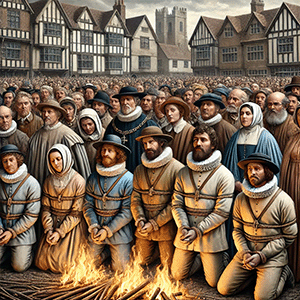The execution of the Stratford Martyrs on June 27, 1556, stands as a poignant episode in the turbulent history of the English Reformation. This event marked the brutal suppression of Protestant dissent during the reign of Queen Mary I, a period characterized by intense religious persecution. The Stratford Martyrs were a group of eleven men and two women whose steadfast faith and ultimate sacrifice have left an indelible mark on history.
 The English Reformation, initiated by King Henry VIII’s break from the Roman Catholic Church in the 1530s, set the stage for decades of religious turmoil. The shift towards Protestantism under Henry VIII and his son, Edward VI, was abruptly reversed when Mary I ascended to the throne in 1553. As a devout Catholic, Queen Mary sought to restore Catholicism in England, leading to the persecution of Protestants who resisted this return to the old faith. Her reign earned her the moniker “Bloody Mary” due to the hundreds of Protestants executed during her attempts to re-establish Catholic dominance.
The English Reformation, initiated by King Henry VIII’s break from the Roman Catholic Church in the 1530s, set the stage for decades of religious turmoil. The shift towards Protestantism under Henry VIII and his son, Edward VI, was abruptly reversed when Mary I ascended to the throne in 1553. As a devout Catholic, Queen Mary sought to restore Catholicism in England, leading to the persecution of Protestants who resisted this return to the old faith. Her reign earned her the moniker “Bloody Mary” due to the hundreds of Protestants executed during her attempts to re-establish Catholic dominance.
The Stratford Martyrs consisted of thirteen individuals: eleven men and two women. These martyrs were common people, including artisans, laborers, and traders, who had embraced Protestantism. Their commitment to their faith made them targets for the Marian authorities intent on eradicating Protestantism from England.
Among them were Thomas Bowyer, Laurence Parnam, William Andrew, and Henry Wye. Their refusal to recant their Protestant beliefs led to their arrest and subsequent trials. They were charged with heresy, a grave accusation under the Marian regime, and faced intense pressure to abandon their faith.
The execution took place on June 27, 1556, in Stratford-le-Bow, a small town in East London. The condemned were tied to stakes and burned alive, a common method of execution for heretics during this period. The event was meant to serve as a grim deterrent to other would-be Protestant dissenters.
On the day of the execution, a large crowd gathered to witness the spectacle. The sight of thirteen individuals, bound and awaiting a fiery death, was a powerful and horrifying testament to the extent of religious conflict in Tudor England. Despite the excruciating pain and fear, the Stratford Martyrs maintained their faith to the end, praying and singing hymns as the flames consumed them. Their composure and steadfastness in the face of such a gruesome death left a profound impression on the onlookers.
The aftermath of the executions saw a mixture of horror and admiration among the populace. While some saw the martyrs as misguided heretics, others viewed them as courageous defenders of their faith. The executions did not succeed in quelling Protestantism; instead, they galvanized resistance against Marian persecution.
The Stratford Martyrs’ sacrifice became a symbol of religious conviction and resistance to tyranny. Over time, their story has been commemorated in various ways, including memorials and plaques in Stratford and other parts of England. Their legacy serves as a reminder of the importance of religious freedom and the enduring human spirit in the face of oppression.
The execution of the Stratford Martyrs on June 27, 1556, remains a significant event in the history of religious persecution in England. Their unwavering faith and ultimate sacrifice underscore the brutal realities of the Reformation era. As we reflect on their story, we are reminded of the vital importance of religious tolerance and the ongoing struggle for freedom of belief. The Stratford Martyrs’ legacy continues to inspire and challenge us to uphold the principles of faith and liberty in our own time.
Leave a comment